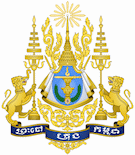Equipment - FARK - Forces Armées Royales Khmères
 The country was almost entirely dependent on outside aid for its armament, equipment and materiel, as well as for much of its military training. The military forces are small, and their armament was limited and unsophisticated, but they were reasonably well trained and competent. Their dependence on outside sources, however, seriously limited their independence of action, and deficiencies were most evident in the materiel field.
The country was almost entirely dependent on outside aid for its armament, equipment and materiel, as well as for much of its military training. The military forces are small, and their armament was limited and unsophisticated, but they were reasonably well trained and competent. Their dependence on outside sources, however, seriously limited their independence of action, and deficiencies were most evident in the materiel field.
Prior to its independence in 1953, Cambodia received military assistance in the form of training and equipment from France. Defense structures and military norms were modeled on the French style. Commencing about 1955, Cambodia began to provide training for reserve officers. This was then followed by the initiation of training of reserve non-commissioned officers. Both categories were volunteers selected from high ranking and mid-level government officials.
Then came the US with its more diversified military assistance. From 1958 through 1963 the United States was the major source of the country's military aid, and a United States Military Assistance Advisory Group (MAAG) provided specialized training in United States-furnished equipment and assisted in staff planning. The FARK now became subjected to transformation in many areas to meet the standard of American equipment – including attempts to change the organization of the force. Unfortunately, the quantity of equipment provided by the US was not sufficient to modernize and support the reorganized FARK. When the US aid was terminated in 1963, the FARK found itself stranded halfway through modernization and military reform.
France furnished some logistic support in materiel and equipment, but it was in the field of training that it continued to occupy a dominant position. In 1967 the French Military Mission was the only such foreign group in the country, and numerous French officers were attached to the general staff in advisory capacities. French advisers were found throughout the military school system, and the majority of Cambodian students in the military services who were trained abroad continued to be sent to French schools and academies.
During this same period, Cambodia received military assistance from other socialist countries – the Soviet Union and China. Consequently, the FARK encountered serious problems, and the divergence of materials affected the training of combat and technical personnel, maintenance and the supply of spare parts and ammunition.
By 1963, however, the country's philosophy of nonalignment resulted in a cessation of United States aid and a sizable decrease in French support. The Cambodian Army had been supplied military aid by both Communist and non-Communist countries. In the late 1960s it attempted to equip the standard Cambodian infantry battalion with the 7.62mm Communist-manufactured family of weapons. This round is not compatible with the 7.62mm bullet used in NATO equipment. Moreover, the ammunition clip was not interchangeable. The basic weapon of each battalion was the AK–47 assault rifle. The battalion generally had 150 rifles. In addition, each battalion had 40 pistols, 120 carbines, 18 light machine-guns, 3 heavy machine-guns, 5 mortars, 3 recoilless rifles and 7 rocket launchers.
The inventory of Communist-supplied weapons was held in Cambodian warehouses under FARK control. This stored equipment could equip almost 43 Cambodian Army infantry battalions. The Cambodians also received weapons and ammunition from the Free World. This equipment was supplied by the United States until 1963 and by the French who continued a military assistance program. “Cambodia: Inventory of Selected Free World-Supplied Weapons and Ammunition,” lists such matériel in Cambodian warehouses. If in good condition, this matériel would equip up to 30 Cambodian Army battalions. A major problem facing the Cambodians was the continued supply of ammunition for either of its family of weapons. Cambodia had no capability to manufacture ammunition. It would seem that the Cambodian Army was capable of considerable expansion simply by the use of stocks of weapons held in their warehouses.
|
NEWSLETTER
|
| Join the GlobalSecurity.org mailing list |
|
|
|

